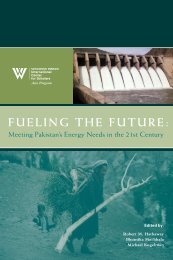Environmental Change and Security Project Report - Woodrow ...
Environmental Change and Security Project Report - Woodrow ...
Environmental Change and Security Project Report - Woodrow ...
You also want an ePaper? Increase the reach of your titles
YUMPU automatically turns print PDFs into web optimized ePapers that Google loves.
impede sustainable solutions to water management<br />
problems, including socio-economic<br />
political disturbances; poverty <strong>and</strong> socio-economic<br />
underdevelopment; insufficient information;<br />
<strong>and</strong> inequities in water allocation,<br />
knowledge, <strong>and</strong> military force. The water sector<br />
is plagued by weak institutions, which often<br />
lack democracy, political will, trained human<br />
capacity, <strong>and</strong> sufficient financial support.<br />
Although some of these obstacles, such as<br />
poor governance <strong>and</strong> changing social values,<br />
are widely recognized, Cosgrove argues that<br />
developing adequate responses will require<br />
further thought <strong>and</strong> debate. The fifth chapter,<br />
“Trends: Emerging Issues <strong>and</strong> Opportunities<br />
for Cooperation,” includes Aaron T. Wolf’s<br />
observations that the shift to less traditional<br />
sources of water (e.g., deep fossil aquifers,<br />
wastewater reclamation, <strong>and</strong> interbasin transfers)<br />
<strong>and</strong> the increase in internally-driven conflicts<br />
might require developing new responses<br />
to transboundary water conflict. Cosgrove<br />
considers increased public participation to be<br />
one of the most important emerging trends;<br />
Chapter 6 collects examples drawn from<br />
Green Cross International’s experiences to<br />
illustrate how NGOs foster cooperation <strong>and</strong><br />
help reach sustainable solutions to water management<br />
problems.<br />
When can obstacles to cooperation lead to<br />
conflict? “Indicators of Potential for<br />
Cooperation” builds on International Waters:<br />
Indicators for Identifying Basins at Risk (Wolf,<br />
Yoffe, & Giardano, 2003), which finds no evidence<br />
that the parameters typically named as<br />
indicators of conflict (e.g., water scarcity, high<br />
population density, low per capita GDP) actually<br />
lead to violence. Instead, Wolf et al. identify<br />
a combination of factors that together establish<br />
a greater chance of hostility: “The likelihood<br />
<strong>and</strong> intensity of dispute rises as the rate of<br />
change within a basin exceeds the institutional<br />
capacity to absorb that change” (page 10). They<br />
find two situations that significantly increase<br />
the risk of a water dispute: (1) the sudden<br />
“internationalization” of a basin, or its division<br />
between nations, such as followed the dissolution<br />
of empires like the Soviet Union, <strong>and</strong> (2)<br />
“unilateral basin development in the absence of<br />
a cooperative transboundary institution,”<br />
which produces rapid physical change without<br />
adequate institutional capacity (page 11). Using<br />
these indicators, Wolf <strong>and</strong> his co-authors identify<br />
17 international basins with the potential to<br />
develop disputes in the next 5 to 10 years, basing<br />
their assumptions on news reports, waterrelated<br />
treaties, <strong>and</strong> literature research. While<br />
this approach can locate basins in trouble, a<br />
more detailed on-site analysis could determine<br />
the actual risk of conflict <strong>and</strong> the most effective<br />
way to foster cooperation in a specific basin.<br />
Pal Tamas’s volume Water Resources Scarcity<br />
<strong>and</strong> Conflict: Review of Applicable Indicators<br />
<strong>and</strong> Systems of Reference (2003) stresses the<br />
relationship between intrastate water tensions<br />
<strong>and</strong> interstate conflicts, <strong>and</strong> emphasizes the<br />
importance of developing conflict resolution<br />
capabilities <strong>and</strong> making incremental advances<br />
in cooperation. Reviewing existing approaches<br />
to predicting conflict, like Clingendael’s<br />
Conflict <strong>and</strong> Policy Assessment Framework 3<br />
<strong>and</strong> the Forum on Early Warning <strong>and</strong> Early<br />
Response (FEWER), 4 Tamas proposes compiling<br />
water conflict indicators. His proposal,<br />
although not fully described, identifies some<br />
101<br />
NEW PUBLICATIONS

















